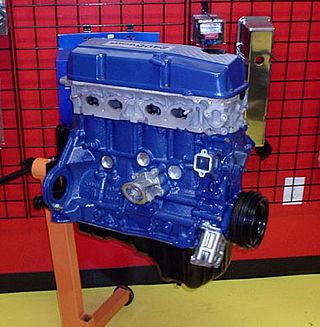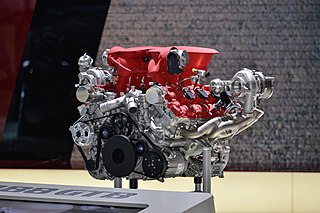
The initial design development for the PowerTech V6 and V8 engine family was done by American Motors Corporation (AMC) and debuted in 1998 with credit to Chrysler. This was the first new V8 engine for Chrysler since the 1960s. The companion V6 was basically the V8 with two fewer cylinders, another concept that originated at AMC before the company joined Chrysler. These new engines had nothing in common with the Chrysler A engine V8s, nor the Jeep 4.0 L "PowerTech" I6 engine.

The General Motors LS-based small-block engines are a family of V8 and V6 engines designed and manufactured by American automotive company General Motors. First introduced in 1997, the family is a continuation of the earlier Chevrolet small-block engine, of which over 100 million have been produced altogether, and is also considered to be one of the most popular V8 engines ever. Spanning three generations, a new, sixth generation is expected to enter production soon. Various small-block V8s were and still are available as crate engines.

The KA engines were a series of four-stroke inline-four gasoline piston engines manufactured by Nissan, which were offered in 2.0 and 2.4 L. The engines blocks were made of cast-iron, while the cylinder heads were made of aluminum.

Atlas is a name for a family of modern inline piston engines for trucks from General Motors, used in the GMT355 and GMT360 platforms. The series debuted in 2002 with the Oldsmobile Bravada, and is also used in the Buick Rainier, the Chevrolet TrailBlazer and Colorado, the GMC Envoy and Canyon, the Hummer H3, Isuzu Ascender and i-370, and the Saab 9-7X. The engines use GM's Vortec name, and Straight-4, Straight-5, and Straight-6 engines are all part of the same family, sharing the same manufacturing equipment, rods, pistons, valves, and other parts. They feature coil-on-plug ignition systems, variable valve timing on the exhaust side, electronic throttle control, and a special oil pan with a pass-through for the half shafts in four-wheel drive vehicles. The inclusion of VVT on the exhaust camshaft side allows the Atlas series to meet emissions standards without the use of EGR, simplifying the engine design and increasing power for a broad power curve. The LL8 shares 75% of its components with the LK5 and L52; while the LK5 and L52 share 89% of their components.

The BMW New Class was a line of sedans and coupes produced by German automaker BMW between 1962 and 1972. These models ensured BMW's solvency after the company's financial crisis of the 1950s and established the identity of BMW automobiles as sports sedans.

The Nissan Z engine is a series of automobile and light truck four-cylinder engines that was engineered by Nissan Machinery, manufactured by the Nissan Motor Company from 1979 through August 1989. All Z engines had 4 cylinders, a total of 8 valves and a single overhead camshaft (SOHC). Displacements ranged from 1.6 L to 2.4 L.The Z series' engine blocks were nearly identical to those of the earlier L Series with the exception of the Z24. While the Z16 and Z18 engines had a deck height similar to the earlier L13/L14/L16/L18 variants, the Z24 had a taller deck height to accommodate a longer stroke. The most notable difference between the Z-series engine and its predecessor was the introduction of a new crossflow cylinder head which reduced emissions by moving the intake ports to the right side of the engine opposite the exhaust ports. This change allows the exhaust port velocity to more effectively scavenge the cylinder and reduce reversion pulses to enhance induction. This change also limits maximum valve lift/lobe lift profiles rendering the cylinder head and valve train configuration undesirable for high-performance uses. The Z series evolved into the NA and KA engines which, along with the smaller CA series, replaced the Z series.

Ford Performance Vehicles was the Melbourne-based, premium performance arm of automobile manufacturer Ford Australia. The company produced a range of Ford-based models from 2002 to 2014 under the FPV marque name.

The Vulcan name has been used by Kawasaki for their custom or touring bike since 1984, model designation VN, using mostly V-twin engines ranging from 125 to 2,053 cc.

The Honda H engine was Honda's larger high-performance engine family from the 1990s and early 2000s. It is largely derived from the Honda F engine with which it shares many design features. Like Honda's other 4-cylinder families of the 1980s and 1990s, It has also enjoyed some success as a racing engine, forming the basis of Honda's touring car racing engines for many years, and being installed in lightweight chassis for use in drag racing. The F20B is a part of the F-series family of engines; it is basically a cast-iron sleeved down destroked version of the H22A. It was developed by Honda to be able to enter into the 2-liter class of international racing.

The L-series is a compact inline-four engine created by Honda, introduced in 2001 with the Honda Fit. It has 1.2 L (1,198 cc), 1.3 L (1,318 cc) and 1.5 litres (1,497 cc) displacement variants, which utilize the names L12A, L13A and L15A. Depending on the region, these engines are sold throughout the world in the 5-door Honda Brio Fit/Jazz hatchback Honda Civic and the 4-door Fit Aria/City sedan. They can also be found in the Japanese-only Airwave wagon and Mobilio MPV.

The Honda R engine is an inline-four engine launched in 2006 for the Honda Civic (non-Si). It is fuel injected, has an aluminum-alloy cylinder block and cylinder head, is a SOHC 16-valve design and utilizes Honda's i-VTEC system. The R series engine has a compression ratio of 10.5:1, features a "drive by wire" throttle system which is computer controlled to reduce pumping losses and create a smooth torque curve.

The Wright R-760 Whirlwind was a series of seven-cylinder air-cooled radial aircraft engines built by the Wright Aeronautical division of Curtiss-Wright. These engines had a displacement of 756 in³ (12.4 L) and power ratings of 225-350 hp (168-261 kW).

The Ford Falcon (FG) is a full-sized car that was produced by Ford Australia from 2008 to 2014. It was the first iteration of the seventh and last generation of the Falcon. Its range no longer featured the Fairmont luxury badge, replaced instead by the G Series.
The Caterpillar C13 is an inline-6 diesel internal combustion engine made by Caterpillar. The engine is 12.5 liters in displacement. The cylinder size is 5.12 × 6.18 bore/stroke. Engine ratings were available from 380–525 horsepower at 2100 RPM. The peak torque occurs at an engine speed of 1200 RPM.

EcoBoost is a series of turbocharged, direct-injection gasoline engines produced by Ford and originally co-developed by FEV Inc.. EcoBoost engines are designed to deliver power and torque consistent with those of larger-displacement naturally aspirated engines, while achieving about 30% better fuel efficiency and 15% fewer greenhouse emissions, according to Ford. The manufacturer sees the EcoBoost technology as less costly and more versatile than further developing or expanding the use of hybrid and diesel engine technologies. EcoBoost engines are broadly available across the Ford vehicle lineup.

The Stadler Eurolight is the brand name for a family of 4-axle Bo'Bo' mainline diesel-electric locomotives with sub-20-tonne axleloads for passenger and freight trains produced by Stadler Rail.

The Ferrari F154 is a family of modular twin-turbocharged, direct injected V8 petrol engines designed and produced by Ferrari since 2013. It is a replacement for the naturally aspirated Ferrari/Maserati F136 V8 family on both Maserati and Ferrari cars. They are the first turbocharged Ferrari road engines since the 1987 2.9-litre F120A V8 of the Ferrari F40.
The Caterpillar C280 is a family of diesel internal combustion engines made by Caterpillar. The engine is 18.5 liters per cylinder in displacement. The cylinder size is 11.02 x 11.81 in. bore/stroke. The engine can produce 2400-7600 horsepower at 900 RPM. The peak torque occurs at an engine speed of 800 RPM. The engine weighs over ten tonnes. The Cat C280 is often used in locomotives and freight-class ships.
The Caterpillar 3126 is a turbocharged 7.2L inline 6-cylinder diesel engine manufactured by Caterpillar and first introduced in 1997; it was the first electronic mid-range diesel engine that Caterpillar produced. It is the successor to the Caterpillar 3116 engine and was updated to become the Caterpillar C7 engine in 2003. It is a medium-duty engine and has been used in dump trucks, long haul trucks, ambulances, buses, RVs, boats, cranes, fire trucks, and more. In 1998, Caterpillar released an improved version, the 3126B; in 2002, the 3126E was released; though these improved versions only affected engine electronics, not the actual engine design. Caterpillar launched a three-tier system of overhaul kits for the 3126 and its C7 successor in 2011.















